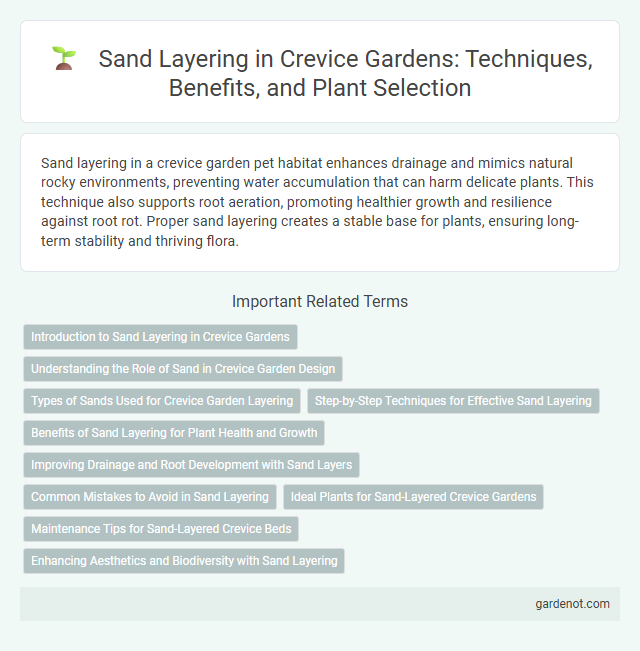Sand layering in a crevice garden pet habitat enhances drainage and mimics natural rocky environments, preventing water accumulation that can harm delicate plants. This technique also supports root aeration, promoting healthier growth and resilience against root rot. Proper sand layering creates a stable base for plants, ensuring long-term stability and thriving flora.
Introduction to Sand Layering in Crevice Gardens
Sand layering in crevice gardens involves strategically placing fine-grained sand between rocks to enhance drainage and root aeration. This technique mimics natural alpine environments, supporting drought-tolerant plants like sedums and saxifrages by preventing water retention that can cause root rot. Proper sand layering promotes healthy plant growth and mimics the mineral-rich substrates found in mountainous crevice ecosystems.
Understanding the Role of Sand in Crevice Garden Design
Sand layering in crevice garden design enhances drainage by creating a porous substrate that prevents waterlogging and root rot. Its granular texture facilitates oxygen penetration to plant roots, supporting healthy growth in drought-tolerant species commonly used in these gardens. Incorporating sand layers also mimics natural rocky habitats, promoting stability and replicating the ecological conditions essential for alpine and Mediterranean plants thriving in crevices.
Types of Sands Used for Crevice Garden Layering
Crevice garden layering benefits from specific sand types such as coarse sand, known for its excellent drainage properties, and sharp sand, which provides structural stability and prevents compaction. Both types create an optimal environment for alpine plants by promoting aeration and moisture control. Choosing well-draining sand varieties ensures healthy root systems and enhances long-term garden durability.
Step-by-Step Techniques for Effective Sand Layering
Effective sand layering in crevice gardens involves first preparing the base by clearing debris and leveling the soil to ensure proper drainage. Next, apply thin, even layers of coarse sand, compacting gently between applications to create stable crevices that mimic natural rock formations. Repeat these layers until the desired depth is achieved, facilitating optimal root growth and water retention for crevice garden plants.
Benefits of Sand Layering for Plant Health and Growth
Sand layering in crevice gardens enhances drainage, preventing waterlogging and root rot while promoting oxygen availability critical for root respiration. This well-aerated environment supports robust root development and nutrient uptake, leading to healthier and more vigorous plant growth. Improved moisture regulation through sand layers also helps maintain optimal hydration levels, reducing stress on plants and encouraging sustained growth.
Improving Drainage and Root Development with Sand Layers
Sand layering in crevice gardens significantly enhances soil drainage by creating porous pathways that prevent waterlogging and promote aeration. The coarse texture of sand facilitates deeper root penetration, encouraging robust root development and improving plant stability. Incorporating sand layers within crevice formations mimics natural rocky habitats, optimizing moisture distribution and supporting diverse plant species adapted to well-drained conditions.
Common Mistakes to Avoid in Sand Layering
Sand layering in crevice gardens often suffers from compaction, which hinders proper drainage and root growth. A common mistake is using overly fine sand that retains moisture, leading to root rot in drought-tolerant plants. Avoid layering without a sufficient gradient, as this disrupts natural water flow and reduces the garden's effectiveness in mimicking rocky crevices.
Ideal Plants for Sand-Layered Crevice Gardens
Sand-layered crevice gardens thrive with drought-tolerant plants such as sedums, saxifrages, and alpine rockery species that require excellent drainage and minimal soil moisture. These plants develop deep root systems ideal for penetrating sandy substrates, promoting stability and water access in the layered crevice environment. Incorporating native succulents and small shrubs like armeria maritima and dianthus enhances ecological balance while showcasing vibrant colors and textures.
Maintenance Tips for Sand-Layered Crevice Beds
Maintaining sand-layered crevice beds involves regular monitoring of sand compaction to ensure proper drainage and root aeration, preventing waterlogging and root rot in drought-tolerant plants. Periodic replenishment of sand layers with coarse, well-draining sand helps sustain soil structure and nutrient flow, essential for the health of alpine and succulent species commonly planted in crevice gardens. Removing debris and managing weed growth through gentle hand-pulling preserves the integrity of the sand layers while minimizing disturbance to delicate plant roots.
Enhancing Aesthetics and Biodiversity with Sand Layering
Sand layering in crevice gardens enhances aesthetics by creating naturalistic textures and color contrasts that mimic rocky alpine environments. This technique supports biodiversity by improving drainage and providing microhabitats for moisture-loving plants like saxifrages and ferns. Effective sand layering promotes root aeration and reduces soil compaction, fostering a diverse range of flora adapted to crevice garden conditions.
Sand layering Infographic

 gardenot.com
gardenot.com